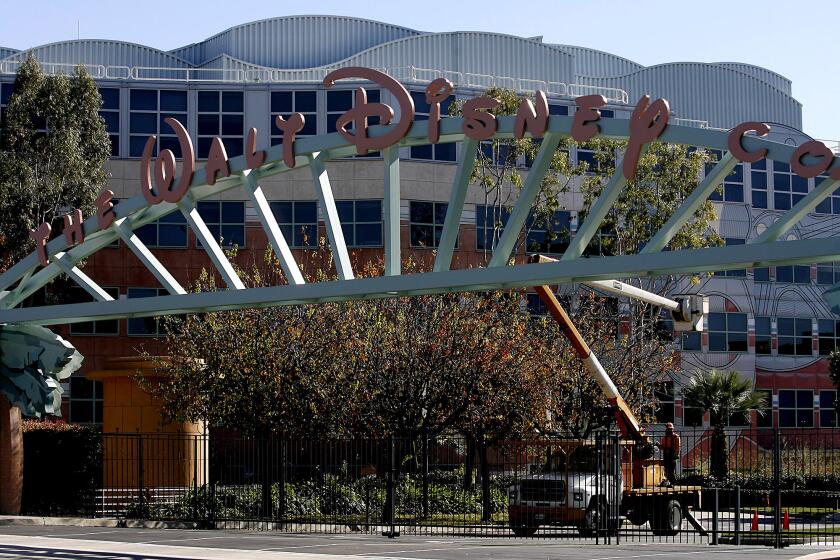Bob Iger announces 7,000 job cuts at Disney, signals ‘significant transformation’

Walt Disney Co. Chief Executive Bob Iger said Wednesday that the Burbank company will shed 7,000 jobs in an effort to save $5.5 billion in costs, marking some of the steepest reductions in the company’s history and the latest sign of Hollywood’s retrenchment.
The belt-tightening underscores the extraordinary difficulties Disney and other media giants face as they reckon with the realities of streaming economics — which have proved more vexing than many anticipated — and the challenges facing Iger, who took over from ousted CEO Bob Chapek in November.
Disney is facing pressure to control costs and boost profits as it continues to lose money from its key streaming business, which includes Disney+.
“While this is necessary to address the challenges we’re facing today, I do not make this decision lightly,” Iger said in a conference call with analysts. “I have enormous respect and appreciation for the talent and dedication of our employees worldwide, and I’m mindful of the personal impact of these changes.”
The cutbacks also reflect an uncertain economic environment, especially for entertainment, media and technology companies that expanded too aggressively during the COVID-19 pandemic. Companies including Warner Bros. Discovery, Snap, Amazon and Meta Platforms (the owner of Facebook and Instagram) have undergone significant layoffs during the last year.
The last major downsizing at Disney occurred in 2019, when the company cut thousands of jobs in the name of efficiency after its $71.3-billion acquisition of Rupert Murdoch’s 21st Century Fox.
According to Disney’s most recent annual report, the entertainment giant has roughly 190,000 employees, including part-time and seasonal staff.
Disney+ has made recent moves to pare its losses with price increases and a new tier with commercials. Netflix, the leader in subscription video, has also taken steps to wrangle costs and increase revenue by introducing advertising and cracking down on password sharing.
Layoffs have been expected for months, even before Iger returned to Disney.
Disney charged aggressively into the business of streaming video subscriptions, in an effort to stay relevant amid the rise of Netflix. But the effort has proved costly, with billions of dollars spent on movies and TV shows to fill the bottomless pit of demand from online viewers. Content spending became an arms race as HBO Max, Apple TV+, Peacock and Paramount+ all vied for viewers’ attention and subscription dollars.
Meanwhile, Disney used low pricing — starting at a bargain of $6.99 in 2019 — and promotional offers in a grab for subscribers, which also hampered profitability. Iger, on the Wednesday call, acknowledged the challenges of competition, pricing and marketing costs.
“In our zeal to go after subscribers, I think we might have gotten a bit too aggressive in terms of our promotion,” Iger said.
He did not specify where or when the layoffs will occur, but they are expected across several divisions, including an unpopular distribution unit created under Chapek.
The streaming race has been a boon for the production of new shows. But the cuts will reduce how much content Disney makes and what the company spends on its movies and shows. Iger said the company plans to examine the costs of “everything that we make” in film and TV. The company expects to deliver $3 billion in content savings “over the next few years,” he said.
Iger singled out so-called general entertainment content — shows that exist outside Disney’s signature brands — as an area he wants to “curate” heavily.
Traditional television has continued to erode, through declining ratings and accelerated cord-cutting, and streaming is a way for Disney to adapt. However, traditional distribution methods (a.k.a. cable bundles and blockbuster movies in theaters) remain profitable, unlike streaming. They’re not businesses that Disney is eager to abandon.
Amid all the talk of downsizing, Iger said that sequels to the “Toy Story” and “Frozen” franchises are in the works.
The company also is seeking the board of directors’ approval to restore shareholder dividends by the end of this year.
Disney’s streaming business continued to bleed cash, losing more than $1 billion during its fiscal first quarter, but the company projects the streamer will be profitable by the end of fiscal 2024.
Disney+ lost 2.4 million subscribers during the first quarter, bringing its total count down to 161.8 million, mainly stemming from declines from its Disney+Hotstar product in India. The service gained subscribers elsewhere, adding 1.4 million subscribers in the U.S. and internationally, not including Hotstar.
Overall, Disney’s streaming apps — Disney+, Hulu and ESPN+ — have 234.7 million subscribers, representing a slight increase of 1 million from October.
Disney’s financial results beat Wall Street estimates. It posted sales of $23.5 billion, up 8% from the same quarter last year. Analysts on average had been expecting $23.4 billion in revenue. Profit rose 11% to $1.28 billion. Disney’s earnings of 99 cents a share exceeded projections of 78 cents.
Disney shares rose 5% in after-hours trading after closing up 0.1% at $111.78 a share.
The investors call was Iger’s first since his return.
At the company’s previous earnings report, Chapek cheerfully delivered the news of strong subscriber increases at Disney+, but that masked underlying problems: disappointing profits, including at the mighty theme parks, and severe losses at the company’s streaming businesses. During the fourth quarter, streaming lost a staggering $1.5 billion for Disney.
Chapek was abruptly ousted in November by the board of directors, which brought back Iger to run the company for two years. He previously ran Disney from 2005 to 2020, a period of transformation that included the acquisitions of Pixar, Marvel and Lucasfilm.
Disney sent a letter to shareholders imploring them not to vote for Nelson Peltz, an activist shareholder trying to gain a seat on Disney’s board.
After his return, Iger quickly moved to overhaul the company. He promised a dramatic restructuring and instituted a policy mandating that employees return to the office four days a week.
Iger laid out the details of the restructuring Wednesday. It divides the company into three units: Disney Entertainment, ESPN and Disney Parks, Experiences and Products. Studio chief Alan Bergman and TV czar Dana Walden will oversee all Disney content, except sports. ESPN, now its own distinct unit, will still be run by Jimmy Pitaro. Iger denied speculation that the separating of ESPN would lead to a sale or spinoff.
“We’re not engaged in any conversations right now or considering a spinoff of ESPN,” Iger said, while acknowledging that it had been considered in his absence.
The parks business is run by Josh D’Amaro. Bergman, Walden, Pitaro, D’Amaro and Chief Financial Officer Christine McCarthy have all been mentioned as possible successors for Iger.
Upon returning, Iger was quickly faced with a challenge from an influential outsider, billionaire activist investor Nelson Peltz. Peltz’s hedge fund, Trian Fund Management, which has a $900-million stake in Disney, has been lobbying the company for a seat on its board of directors, and Peltz has criticized the company for “self-inflicted” wounds, including poor succession planning and the costly acquisition of 21st Century Fox, which brought in franchises like “Avatar” but saddled the company with debt.
Peltz’s overtures have been going on since July. After being rebuffed, Peltz embarked on a proxy fight with Disney early this year, encouraging shareholders to vote for him (or his son, Matthew) to join the board and also to vote against current board director Michael Froman, a former U.S. trade representative.
Disney has been campaigning hard against Peltz, accusing him of being out of his depth when it comes to the media and entertainment business.
The company recently appointed former Nike Chief Executive Mark Parker as its next chairman, who will lead a succession-planning committee to find Iger’s replacement. During Iger’s first run as chief executive, he delayed his retirement multiple times. After handpicking Chapek as his successor, he quickly became disillusioned with the choice.
Parker replaces Susan Arnold, who is termed out after 15 years on the board.
The fight with Peltz will come to a head in early April, when Disney holds it annual shareholder meeting virtually, at which investors will vote on Disney’s 11-member board.
More to Read
Inside the business of entertainment
The Wide Shot brings you news, analysis and insights on everything from streaming wars to production — and what it all means for the future.
You may occasionally receive promotional content from the Los Angeles Times.












